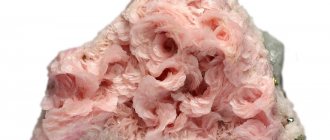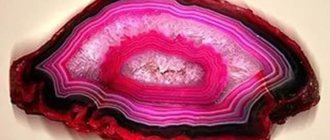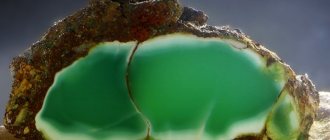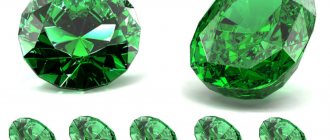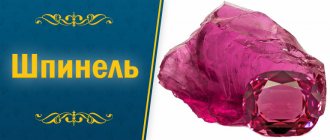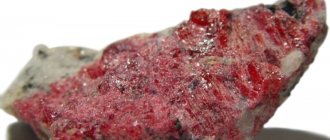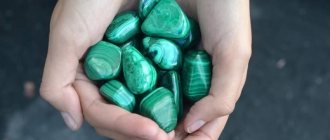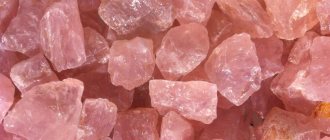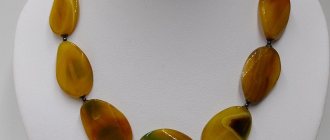Zircon
— mineral, (Zr,Hf,Th, U,Tr,Ca,NaX(Si,Al,P,S)X x(),OH)il. Tetragonal habit: various combinations of prisms and dipyramids. double cranked by {101}. aggregate: dissemination of crystals, granular, collomorphic deposits. Brown in different shades. Diamond shine, greasy. hardness 6.5. specific gravity 4.0-5.1. In granitoid and alkaline rocks, pegmatites, albitites, carbonates; in placers. Ore Zr. variety: arshinovite, gelzircon, alvnt, naegite, hagatalite, yamagutilite, oyamalit, malakon, cyrtolite, hyacinth, Auerbachite, jargon, etc. Used to determine absolute age using the lead method.
The name zircon comes from the Persian words distorted over time: king - gold and gun - color. Possibly from the Greek kirtos - curved, convex (meaning the curvature of the edges of crystals).
Synonyms for the mineral zircon: hyacinth.
Zircon
Zircon is a fairly common accessory (minor in quantity) mineral in a number of acidic and alkaline igneous rocks (granites, syenites, nepheline syenites).
Zircon formula Zr[SiO4].
History's mistakes and cuckoo zircon
It is assumed that the names zircon and zirconium come from the Persian (distorted) words “tsar” - gold and “hun” - color. That is, the stone is the color of gold.
There is a version that the name of the gem comes from the Arabic “zargun” - cinnabar.
In the East, the shining stone was called the mother of the diamond or its younger brother.
For a long time (until the 18th century), Ceylon gems were brought (and bought) in Europe like diamonds. In general, the gem was mistakenly attributed to the royal family of diamonds. It was easy to make a mistake - the semi-precious stone has a shine comparable to diamond. And even fancy diamonds cannot compare with the color “assortment” of the gem. So, before the advent of instrumental methods for analyzing stones, zircon, like a cuckoo bird, was “thrown” into the nest of diamonds by human opinion.
Russian chemists already at the beginning of the 19th century called zirconium “zircon” or “zircon”.
Place of Birth
Zircon
Sri Lanka is invariably the leader among zircon miners. It was there that they came up with the idea of cutting zircons like diamonds and selling them under the guise of the latter, although with the development of technology and increased knowledge among people, such a “trick” now rarely works.
The mineral is also mined in other places on the planet - on the island of Madagascar, in the USA and Canada, Brazil and Norway, in Thailand, Vietnam, Burma and Tanzania.
No zircon deposits have been discovered in Russia; the stone is mined as a companion to other gems in the Urals and Yakutia.
Physics and chemistry of gems
Characteristics of the mineral:
- has a resinous, glassy to diamond luster, which gives a high refractive index;
- can be transparent, translucent, opaque;
- dash color is white;
- average hardness 7.5 on the Mohs scale.
Zircons necessarily contain rare earth and radioactive elements, as well as copper, titanium, iron, zinc, and calcium.
| Color | brown in various shades, sometimes white, colorless, rarely red, green, yellow, black |
| Stroke color | white |
| Chemical formula | Zr [SiO4] |
| Shine | bold, diamond |
| Transparency | transparent, translucent |
| Cleavage | imperfect |
| Kink | conchoidal, uneven |
| Hardness | 7-8 |
| Specific gravity | 3,9—4,7 |
| Selection form | in the form of well-cut pointed crystals of long-prismatic and bipyramidal habit. The main simple forms are (110), (100), (112), (101), (211) and (331). Zircon twins are observed along (101), rarely along (111) and (211) |
| Classes on taxonomy of the USSR | Silicates |
| singonia | tetragonal |
| Additionally | yellow transparent zircon - hyacinth is transparent. P. tr. doesn't melt |
The color range of gems is quite wide. They come in various shades of brown (from yellow-brown to reddish-brown), red, green, gray or pale gray, pink. There are black and colorless crystals of the mineral.
Curious: if you are in London, go to the Natural History Museum. There is a magnificent collection of zircons collected by Sir A. Church.
Physico-chemical characteristics
The physical and chemical properties of a substance depend on its composition:
- Zirconium freed from impurities is plastic and easily processed at any temperature (forging, stamping, rolling).
- Even small fractions of gases (nitrogen, hydrogen, oxygen, carbon) in the composition make the ductile metal brittle. For example, the presence of more than 0.2% oxygen excludes pressing.
- At 200°C it becomes covered with an oxide film. The color of the metal changes.
Impurities in the composition worsen the characteristics of zirconium.
| Properties of the atom | |
| Name, symbol, number | Zirconium (Zr), 40 |
| Atomic mass (molar mass) | 91.224(2) a. e.m. (g/mol) |
| Electronic configuration | [Kr] 4d2 5s2 |
| Atomic radius | 160 pm |
| Chemical properties | |
| Covalent radius | 145 pm |
| Ion radius | (+4e) 79 pm |
| Electronegativity | 1.33 (Pauling scale) |
| Electrode potential | 0 |
| Oxidation states | 0, +1, +2, +3, +4 |
| Ionization energy (first electron) | 659.7 (6.84) kJ/mol (eV) |
| Thermodynamic properties of a simple substance | |
| Density (at normal conditions) | 6.506 g/cm³ |
| Melting temperature | 2125 K |
| Boiling temperature | 4650 K |
| Ud. heat of fusion | 19.2 kJ/mol |
| Ud. heat of vaporization | 567 kJ/mol |
| Molar heat capacity | 25.3 J/(K mol) |
| Molar volume | 14.1 cm³/mol |
| Crystal lattice of a simple substance | |
| Lattice structure | hexagonal |
| Lattice parameters | a = 3.231, c = 5.148 Å |
| c/a ratio | 1,593 |
| Debye temperature | 291 K |
| Other characteristics | |
| Thermal conductivity | (300 K) 22.7 W/(m K) |
| CAS number | 7440-67-7 |
Fine powdered zirconium ignites at “medium” temperatures. This is the only drawback of metal.
Color and name
Some zircons are honored to have a personal name, and it is given according to the color of the natural mineral.
The varieties of the mineral amaze not only with their diamond shine, but also with the variety of their palette.
- For a long time, the “little brothers of diamond” were imported to Europe from one place - Ceylon (now Sri Lanka). The color scheme of the “brothers” ranges from brown-orange, through yellow to olive-green. Colorless crystals were also found (or maybe ancient craftsmen annealed the stones). Such colorless gems were called “matura diamonds.”
- Jargon, or Siamese zircon is a straw yellow, golden yellow or smoky gem.
- Hyacinth often resembles the flower of the same name in color. They are red-brown, red or brown, orange.
Earrings with hyacinth - Starlite is a bright blue stone. The appearance of natural gems is extremely rare. Almost all starlites received color by annealing brown zircons.
- Malacon. Brown-black, black gem. It has weak radioactivity.
- Green zircon does not have its own name. However, it always has radioactivity. And if pale green stones “give off” little light, then bright green ones can be dangerous if worn constantly.
Interesting: starlite got its name from the chief gemologist.
But Pliny, the author of Natural History, was not impressed by hyacinth: “Hyacinth is sharply different from... amethyst, although they are similar in color. The greatest difference is that the bright violet color, so brilliant in amethyst, is diluted in hyacinth.”
Origin of the stone
What is zircon? This is, first of all, one of the most ancient stones on our planet. For example, scientists once discovered a specimen in Australia that is 4.4 billion years old—almost as old as the Earth.
This is one of the most ancient minerals on the planet.
Previously, the stone was constantly confused with various other gems: chrysoberyl, tourmaline, amber. Dishonest traders even passed off transparent specimens of the mineral as diamonds. However, no one has studied the properties of the stone itself.
The inhabitants of Europe were able to appreciate this gem only in the fifteenth century. Brown-red crystals were called hyacinths, honey-gold ones were called jargons, and blue ones were called starlites. The first zircon sets and jewelry appeared, which were popular with the nobility.
During the Soviet era, zircon faced another problem. When artificial diamonds and cubic zirconia were grown at the Lebedev Physical Institute of the Russian Academy of Sciences, their other name, Zirconia, took root in the West. Since laboratory gems are “dead” from the point of view of magic, American and European psychics did not use cubic zirconia. Due to the similarity of the name, many confused them with zircons. There is a common misconception that crystals are useless.
Where is the “mother of diamonds” used?
Don’t think that our gem is a slacker who can only show off in jewelry. Its meaning for a person is priceless.
The scope of application of the mineral includes the extraction of zirconium and hafnium from it.
Zirconium replaces expensive platinum in instrument making and in the production of spark plugs for internal combustion engines.
A rare property of zirconium is its exceptional corrosion resistance (well, it doesn’t want to rust). Products made of zirconium and its alloys are not destroyed in cold solutions of acids, alkalis, or ammonia. Sea water does not corrode this metal.
The properties of zircon stone allow it to be used in various industries.
The mineral is used to produce zirconium dioxide. It is used to produce particularly durable paints and is added to heat- and acid-resistant laboratory glassware.
The Ministry of Health has authorized the use of zirconium alloys in the manufacture of endoprostheses, implants, and dentistry.
Nowadays, real zircons are almost impossible to find in jewelry. Cubic zirconia is now usually sold under the brand name “zirconium” instead of natural gem crystals. But in ancient jewelry, natural gems are found quite often.
Ring with cubic zirconia stone
Scope of application
The area of application of jewelry-quality zircons of all colors is inserts into jewelry. The best frame is considered yellow gold, silver is found, platinum is not used. There is expensive, elite jewelry with hyacinths, malacons and starlites.
Ring with clear zircon
Zircon jewelry includes earrings, rings, pendants, and less commonly, tiaras and pendants. Necklaces are rare.
The main role assigned to clear crystals is to be substitutes for diamonds. They are cheaper than a diamond, but more expensive than cubic zirconia.
The main types of cuts are diamond or cabochon.
The price per gram of this mineral starts at $50, depending on its quality.
Let's be clear
For many, zircon and zirconium are the same thing. And if we talk about cubic stabilized zirconium, then the majority will be at a dead end.
But in fact, everything is simple.
Zirconium is a metal. In the periodic table of Mendeleev (ugh, about chemistry, most will say...) a metal with atomic number 40. Write Zr to a chemist, and he will automatically read “zirconium”.
Zircon is the name of a mineral whose crystals are used in jewelry. Chemical formula of ZrSiO4. Take a closer look and you will see the designation zirconium in the formula.
Cubic stabilized zirconium, or simply cubic zirconia. A magical invention of magicians and sorcerers from the Lebedev Physical Institute. "The Poor Man's Diamond", a stone with excellent jewelry qualities. In the jewelry industry, colored artificial zircon is used as a substitute for expensive precious stones.
Important: abroad it is called zirconite.
If you see “zirctone” in the window, don’t consider it the seller’s illiteracy.
Zirkton is a brand name for synthetic corundum that is bluish-green in color. Sold as imitation sapphires.
And there is also citrine (you can read about it here), but that’s a completely different story.
Sorcerers from FIAN
When looking at cubic zirconia, one always remembers the Strugatsky brothers’ masterpiece “Monday Begins on Saturday.” In this book, real magicians and sorcerers worked at NIICHAVO.
The same sorcerer scientists created a “cubic stone”, cubic zirconia, at the Lebedev Physical Institute. Simple formula - zirconium dioxide, minimum price. And the result is amazing.
The main “work” of cubic zirconia is its use in jewelry.
It was called the "poor man's diamond." Low price, the possibility of adding substances that give color to cubic zirconia, diamond shine - these are the advantages of synthetic stone.
There are seven types of "poor man's diamond" color:
- when adding cerium, the resulting pebble will be red, yellow, or orange;
- add erbium - cubic zirconia will turn pink;
- can be sold for greenish sapphire if chromium is added to cubic zirconia;
- combine with a small amount of titanium - we get a stone of a golden-brown (cognac) hue;
- If the goal is to get an imitation of kunzite, sapphire, amethyst - add neodymium and get purple cubic zirconia.
Every woman wants to wear sapphires and diamonds. It's not always her fault that she doesn't have such jewelry.
But every woman can buy earrings or a ring with cubic zirconia. And feel like a goddess!
Let's refine the gem
Just heating (annealing) the stone, and what an effect! Brownish Cambodian zircons take on a stunning blue color. Connoisseurs compare it with expensive Paraiba tourmalines.
And if you burn the gem a second time, but in an oxygen atmosphere, the color will change to yellow. But yellow is different from yellow. Here you get just a piece of sun in the palm of your hand.
The sheaves of rays from the facets of the gem blind the eyes, and the gem shimmers in the sun incredibly beautifully!
Interesting: the most beautiful blue zircons are obtained by heating Cambodian gems.
Who suits the name
Transparent zircon
The name is of great importance for a person, including when choosing talisman stones.
Zircon gives preference to owners of the following names:
- Vyacheslav . He will have the ability to predict events. Slavs will learn to “see through people,” expose lies and flattery, and also sense danger.
- Nikolai . This man should choose hyacinth as his life assistant. Red gems will guide them on the right path, help them achieve success in their chosen business and provide new opportunities for development. All zircons will become a symbol of wealth and prosperity for Kohl.
- Matvey . He is favored by all varieties of gems, but especially warm colors (yellow, red, brown). They will make the bearers of the name luckier, protect them from rash actions and fatal mistakes.
The stone has its favorites among the fair half of humanity - these are:
- Diana . Zircon will attract financial flow to them. Diana’s business will go uphill, problems will be solved, and new profitable ideas will come to her head.
- Nina . The owner of a name with zircon will become morally stable, will easily survive troubles in the present and will be able to get rid of the burden of past disappointments.
- Galina . Shy and demanding Galina will become more sociable and easy-going. She will learn to look at life more optimistically and greet every new day with a smile.
Gem magic
Zircon is a stone of truth and justice. The magical properties of zircon will bring deceivers and scammers to the surface. A talisman or gem jewelry will help judges, criminologists, and scientists.
The energy of the gem is masculine. A ring with a stone of a calm color and a tie pin will well complement the image of a successful man.
The zircon stone will create all sorts of obstacles for liars and scammers, and can cause great harm in scams. In any case, initiates have been confident of this for a long time.
Moms and dads! Give your daughters earrings with zircon in yellow shades. The girl will be happy with the decoration, and the magic of the mineral will increase perseverance and diligence in her studies. That's what the esotericists say.
From ancient times to the present day in India, girls wear zircon stones. They are sure that the amulet will protect against temptations and (since it did not protect) from unwanted pregnancy.
Esotericists believe that excessive fatness is a disorder in the physical and spiritual parts of a person. The energy of the mineral brings both of these parts into balance. Therefore, overweight people are advised to wear a pendant or pendant made of gems.
The magical properties of zirconium
Amulets, pendants, talismans and other jewelry made from Zirconium stone have become widespread. It has long been considered endowed with the ability to bring wealth and success to its owner. In ancient times, the mineral was the property of sages; it was believed that it brought them knowledge of the future, the gift of insight and the ability to penetrate the thoughts and inner world of other people. Worn as an amulet, zircon served as protection against liars and unkind people, and developed observation and memory.
The Zirconium mineral has many magical properties. In ancient India it was believed that he was able to control the sun and moon. This stone is widely used in various areas of industrial production; moreover, it is considered an ideal talisman for businessmen, intellectual workers, and travelers. It can even serve as a protective amulet for lovers, strengthening the spiritual and emotional connection between people. A hyacinth amulet will help travelers and military personnel maintain their health and life.
Help with treatment
Lithotherapists are confident that the healing properties of the mineral help heal nervous disorders and cope with mental problems.
It has long been believed that the stone alleviates the condition of patients with coronary heart disease.
Anesthesia, intoxication during poisoning - zircons can cope with this (as esotericists say). It is useful to wear earrings with the “little brother of the diamond” for vision problems.
Stones of different colors “work on different diseases”:
- blue - speed up metabolism, help cope with constipation, reduce appetite, promote weight loss;
- dark red and black will help cope with colds;
- yellow and yellow-red help the liver function and drive away nightmares.
Of all the zircons, lithotherapists consider hyacinth to be the most powerful.
The healing properties of zirconium
Companies specializing in the manufacture of bracelets began to add particles of the Zirconium element to their products in order to give their products medicinal qualities in order to increase their sales. The bracelets supposedly lower blood pressure. It is believed that the stone can give strength and vigor throughout the day and ensure sound and healthy sleep at night. It does not change its properties when exposed to acids, therefore it is often used in the manufacture of medical instruments and equipment. More information about medicinal properties:
- accelerates wound healing;
- prevents the formation of pus;
- good antiseptic;
- has an antimicrobial property, which prevents the penetration of various infections into the body;
- prevents the penetration of radiation;
- helps relieve allergy attacks.
- Causes of high blood pressure during pregnancy
- Diabetes mellitus type 2 - diet and treatment: nutrition for the disease
- How to dry the body of fat for a man or woman - nutrition and training for drying
Many types of stone, according to experts in the field of lithotherapy, have a positive effect on the functioning of the thyroid gland and endocrine system. At the same time, different properties are attributed to different colors:
- Black. Helps overcome the effects of hypothermia and colds.
- Yellow and red. Increase appetite and leukocyte production.
- Brown. Able to get rid of accumulated waste.
- Blue and blue. They help remove extra pounds, improve the functioning of the digestive tract, and normalize stool and appetite. The same properties are attributed to transparent minerals.
Astrology
The patron planets of the mineral are the Sun and Saturn.
For Capricorns, zircon is a lucky find. Representatives of this zodiac sign can collect a whole collection of gems of different colors. Each pebble will give Capricorn its help.
The mineral has a light disposition:
- Sagittarius;
- Aquarius;
- Scales;
- Aries;
- Taurus.
The gem will easily make friends with these signs. You just need to choose the right color:
- Aquarians can choose colorless, yellow, blue, golden colors.
- Capricorn will receive the best help from yellow and blue stones. But gems of a different color will go very well with it.
- Aries - the fiery lamb - will like jewelry with red and golden gems.
Cancers and Pisces should either not wear zircons, or wear them infrequently - the stone is not suitable for these zodiac signs.
Let's preserve zircon in all its glory
Caring for a gem is easy.
Zircon is a fragile stone. Do not apply mechanical force to it, drop it, or scratch it.
If you buy jewelry with the “mother of diamonds”, make sure that the stones are in special, high frames.
The gem does not tolerate household chemicals. So before washing dishes or washing, the ring with the zircon insert will have to be removed.
It is better to wash contaminated jewelry in warm water with baby (neutral) soap. Rinse under running water, dry carefully with a cloth.
Store jewelry with zircons separately from other jewelry. In bags made of soft, thick fabric, in cases, boxes or caskets, lined with soft (velvet, plush) material on the inside.
Jewelry with mineral
Jewelry quality specimens are widely used in this industry. The best metal for the frame is considered to be yellow gold, less commonly silver. This mineral is not set in platinum, but you can find expensive luxury jewelry with different subtypes of the stone - malacon, hyacinth, starlite.
Transparent zircon crystals play the main role, taking the place of diamond substitutes. The brilliance of the gem is not inferior to that of a diamond, but costs several times less. The sale of jewelry is carried out in different pricing policies, depending on the type of stone, cut, and metal of the product:
- Earrings can be purchased for either 7 thousand rubles or 25 thousand.
- Prices for rings start at 7 thousand rubles.
- Pendants cost from 4 thousand rubles.
- A thin necklace with small pendants is estimated at 8-10 thousand rubles, but a massive product will cost 50-60 thousand.
Beads made from unprocessed hyacinth will cost about 4 thousand rubles. It is worth considering the fact that many jewelers replace zircon with cheaper cubic zirconia. Therefore, when buying jewelry, it is better to clarify the origin of the stone.
Counterfeits, imitations, synthetics
A natural mineral suitable for jewelry is becoming increasingly rare. To be honest, you can hardly find it in jewelry stores. But there are a lot of artificial stones.
Let's try to find the difference between a natural gem and zircon:
- A magnifying glass will help you. Let's take a closer look at the stone. In the present there will always be inclusions, voids and other traces of natural origin. Synthetic stone does not have such traces.
- Sometimes a natural gem is weakly radioactive. There is a device for determining radioactivity - measure the background from the stone.
- Zircon looks and shimmers like a real diamond. But only where there are inclusions or a resinous tint.
Red gems with a purple tint can be passed off as high-quality amethyst. Green zircon is sometimes passed off as demantoid, chrysolite, even emerald. Blue can be sold as sapphire. Although the properties of these stones have strong differences.
Methods for obtaining zirconium
A stone with a metallic luster and a variety of shades is obtained experimentally in specialized laboratories. It is based on zircon, the main deposits of which are located in Australia, Brazil, Vietnam, Thailand, Sri Lanka and some other countries of the world. Synthetic stone is obtained in one of the following ways:
- Fusion with soda or soda. The process is carried out at a temperature of 500 to 600℃.
- Chlorination with carbon. Performed at a temperature of 900-1000℃.
- Fusion with potassium. Performed at 900℃.
- Sintering with lime or calcium carbonate. Carried out at 1100-1200℃.
